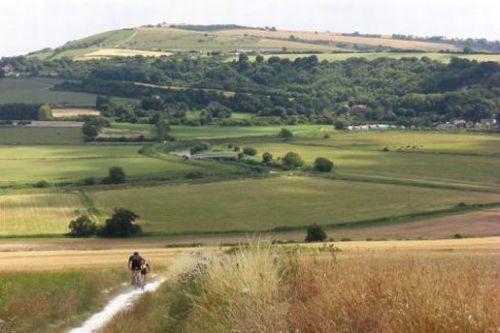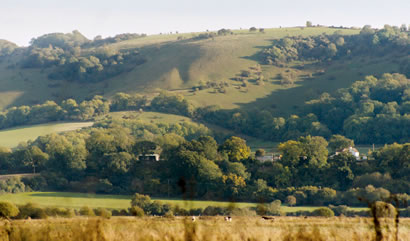http://www.bbc.co.uk/i/b01j2bzr/
When I listed to this on the BBC (Houses v Fields, Archive on 4, available until Saturday 2nd June), I started thinking about how the countryside could change in the future. Debate over loss of countryside to build houses (and other) has long been a big issue in the UK, especially as more and more land has been covered in tarmac and concrete, but I wanted to think about it within a future scenario of peak oil and energy descent.
My own position is that I have long harboured a dream of having some land, a few acres, to nurture. I feel that the angle of this debate should be much wider, and not just about houses. It is about our relationship with the land, which has diminished as we have urbanised and lost a connection with the land, as well as all those skills that previous generations had.
It’s more about what we want our countryside to be or become in coming decades, and less about the blinkered vision of unspoilt fields versus urban sprawl. Why do we have to think about Houses versus Fields in such stark and absolute terms? To think in these terms alone fails to realise an alternative approach which could be much more relevant to a post-peak oil society.
Here is the original synopsis provided with the radio programme:
Which is a better use of our land? A beautiful green field, or a human home? We have long tied ourselves in knots trying to answer this question. Anne McElvoy ploughs the BBC archive to unearth the tangled roots of one this country’s great, eternal inner conflicts.
Anne listens to a stinging mid-century polemic against new ‘ribbon developments’. And she finds out which writer was so incensed at suburban sprawl that she burned cardboard models of suburbs in her garden.
But she also hears interviews with those who had managed to flee the slums and who were enraptured by the fresh air on new estates. One ex-EastEnder is agog simply at the fact that she has running water upstairs.
In this new, planning-friendly world, Prime Minister Winston Churchill broadcast to the nation on the virtues of the new emergency pre-fabricated houses – complete with “excellent baths”. He expresses impatience with those who would “plan every acre” to ensure the landscape was not spoiled.
But she also hears the rough reception that greeted the Minister who ventured to Stevenage to extol the virtues of the coming new town.
This opposition to new building on ancient fields came to a new crisis in the 1980s when the boom in the south east led to extraordinary tensions. Environment Secretary Nicholas Ridley backed plans to build new settlements in the Home Counties. Protestors burned him in effigy in a Hampshire field.
And with the Coalition Government now introducing fresh plans to encourage development while empowering local communities, Anne asks Planning Minister Greg Clark how he is trying to resolve the struggle between houses and fields.
So, houses get a rough deal, but surely, people have to live somewhere. Why not the countryside? It doesn’t mean that we have to build ugly boxes that are destined to become the slums of tomorrow. We could allow a reconnection of people and land by enabling a radical re-appraisal of land-use. What if it was possible to buy a few acres and then live on that land too?! It sounds logical, but current planning restrictions make this all but impossible for most of us.
How we use land in a future shaped by climate change, resource deplation and energy descent is going to be radically different to today. ‘Fifty million farmers’ is the title of an essay by Richard Heinberg which suggests that in the future we will need far more people producing food than today. Fifty million is the rough estimate of how many farmers would be needed in the USA if we couldn’t rely on fossil fuels for transportation, chemical pesticides or fertilisers. This equates to about 15-20% of the country’s population.
Current UK agricultural workers number around 123,000. If we were to use the same ideas developed above for the UK, we might be looking at just 5 or 6 million farmers out of a total working population of around 29 million.How would that start to change the landscape? How would it impact on what gets taught in schools? This is where things start to get interesting and we can begin to construct a whole new vision of the countryside and our relationship with land.
For example, how about the Land Matters Project in south Devon?
This is a 42 acre community, low impact and off-grid. There was some local opposition, but it finally got temporary planning permission for 3 years for 8 low-impact dwellings, after support from The Land is Ours, (campaigning for a planning system which actively encourages sustainable, low impact and affordable homes). In April 2011 they were given a further 5 years’ permission. Former agricultural land was transformed into a community. Is this the future?
Yesterday, I drove the through some of southern England’s most breath-taking countryside. From Arundel I took the road that runs between Arundel Park and Dalesdown Wood, went through Houghton and Amberley, taking in some spectacular views of the South Downs. It was hard to think of landscapes such as these covered with housing. But, gorgeous as the fields were, they were empty of people. There were a few small villages, plus a handful of isolated dwellings, but mostly fields.
Covering any landscape in huge housing estates/suburbs makes no sense if we fail to plan for future resilience. If the housing is car-dependent commuter villages with little scope for self-reliance, then it would be a wasted opportunity and one which has no future. We need to revisit our attitudes on how we use land in the future.
Increasing use and dependence on fossil fuels over the past two hundred years has moved people away from rural settlements into urban ones. This happened in England during the 19th century and continued into the 20th century, making rural living either the preserve of the wealthy or of the isolated minority clinging to a moribund existence. Those farms that remain have often been consolidated into large holdings (500+acres), whilst the smaller-scale family-run, mixed farms have mostly disappeared. Access to land has become increasingly skewed during this period. As explained in the current issue of The Land: ‘Currently, in our “property-owning democracy”, nearly half the country is owned by 40,000 land millionaires, or 0.06 per cent of the population, while most of the rest of us spend half our working lives paying off the debt on a patch of land barely large enough to accommodate a dwelling and a washing line.’
At present, much of the rural economy is based on tourism and heritage. In effect, some of the most fertile land in the world is being used as a backdrop to a version of the countryside that is static and more about visitor experience than about life and food; more concerned with conservation than creativity. It amounts to a Disneyfication of the countryside. Ugg! Is this something we can afford in a future of energy descent?
Speaking personally, I moved to a South Downs village just north of Worthing, five years ago. I am now living in a National Park (?!) I wanted to enjoy the countryside and all it offered, but five years on and I am still on the waiting list for an allotment. I am surrounded by land, but there is none available for me to use. Transition Findon was set up partly with the aim of starting up a community allotment or garden, so we’ll give it our best shot.
How many urban dwellers long to live in the country? Having a smallholding is unfortunately beyond the means of most of us. Even a modest dwelling with a few acres in SE England is likely to set you back £600,000+ However, redefining landuse and farming could be a key feature of how we could use the countryside in coming decades. To see a patchwork of productive small farms of five or ten or twenty acres, creating food, livelihoods and skills would be wonderful. Seeing some human life where we now have industrial-scale monocultures would change the countryside. It’s not Houses versus Fields. It’s imagination versus no imagination.



